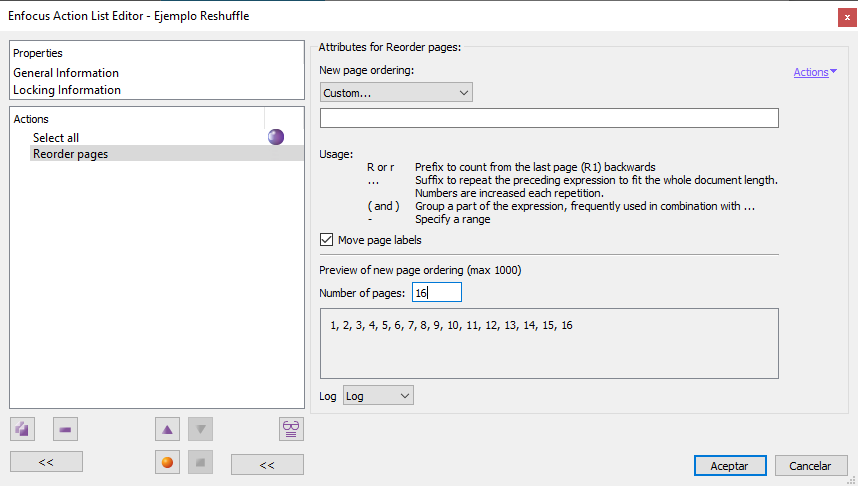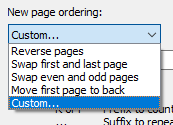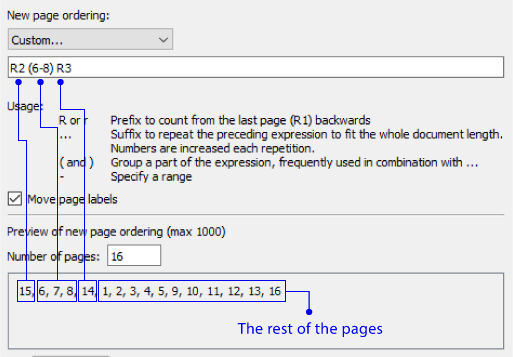
This Enfocus PitStop command allows pages within a document to be reordered according to a new sequence specified by the user.
![]()
In the option "Number of pages" we must write down how many pages the document has (we cannot leave it empty or the command will do nothing). It is not mandatory to enter the actual pages of the document. We may put more (the excess will not be taken into account) or less (the pages beyond the limit will not be processed, it will be as if they did not exist).
These restrictions are in place:
- The maximum number of pages this command admits is 1,000 (but the document can be longer).
- If the command specifies any non-existent page, that page is ignored but the rest of the command is executed.
- If we specify an amount of pages lesser than the real number of pages in the document, the command is executed only on that batch of pages, as if the rest did not exist.
- If the command refers to the same page more than once, all sortings are carried out to the end in a sequence (whenever possible).
Warning: The number used to move around the pages is their position when the command is executed. Page numbering or the like is not taken into account; that is: "15" means the fifteenth page, not the page numbered as "15" (if it exists).

There are four preset "New page orderings" and one "Custom". All of them display the reordering sequence chosen on the blank line below. So, we can modify them (making them "Custom" reordering):
- "
Reverse pages": The order of the pages is completely reversed. "R1..." - "
Swap first and last page": Both pages are exchanged, the others do not move. "R1, 2..., 1" - "
Swap even and off pages": All even pages become odd pages and vice versa. "(2, 1)..." - "
Move first page to back": The first page goes to the end. The others do not move. "2..., 1" - "
Personalizada": The order specified in the next line is used according to the syntax explained below.
Reorder syntax
- Pages that are specified in the "
New page ordering" line are affected. Those not mentioned remain as they were and are placed after those affected by the reordering; for example: "2,6, " (and not writing anything after) means "Place page 2 first, then page 6 and then the rest, as they were". - "
x": A specific page number, e.g. "5" means "page 5". - Several different pages are numbered one after the other, separated by spaces or commas (which are not taken into account); for example: "
1 15 12" (or "1,15,12") means "1, 15, 12". - "
x..." (ellipses): From number X onwards; e.g. "2..." means "From 2 onwards". - "
x - y": A sequence of pages from X to Y; e.g. "6-10" means "From sixth to tenth". - "
Rx" : Page X counting backwards, from the end, e.g. "R5" means "the fifth page from the back". - "
Rx..." (R with ellipses): Reverse count until further notice; e.g. "R1...") means "reverse all pages". - "
(x y z)": (Parentheses) A sequence of orderings that we want to isolate; for example: "R2 (6-8) R3" means "The second last, then from the sixth to the eighth, and then the second last but one (and then the rest)".

Because it is so easy to make mistakes, in the lower area the programme displays on the fly the result of the sorting as we enter it in "New page ordering".
The "Move page labels" option causes page labels to be included in the reordering.
Advertencia: Enfocus advierte de que, en la versión que no es de servidor que funciona con Acrobat a veces la reordenación puede no apreciarse si el documento no se cierra y vuelve a abrir.
[© Gustavo Sánchez Muñoz, 2025] Gustavo Sánchez Muñoz (also identified as Gusgsm) is the author of the content of this page. Its graphic and written content can be shared, copied and redistributed in whole or in part without the express permission of its author with the only condition that it cannot be used for directly commercial purposes (that is: It cannot be resold, but it can form part as reasonable quotations in commercial works) and the legal terms of any derivative works must be the same as those expressed in this statement. The citation of the source with reference to this site and its author is not mandatory, although it is always appreciated.